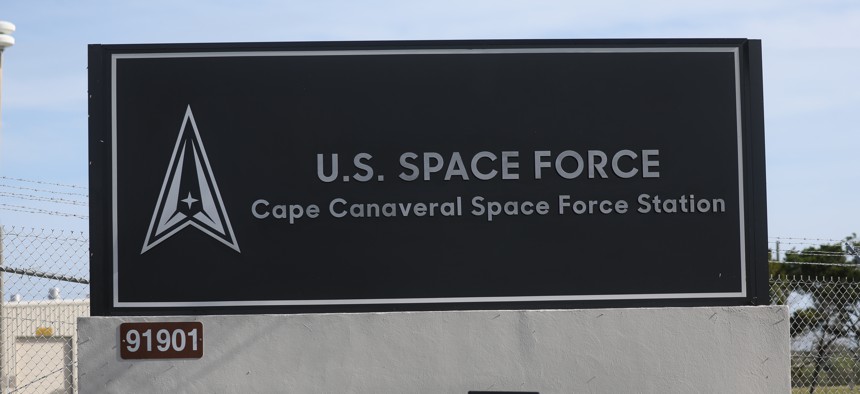Space Force Has a Major Satellite Oversight Problem, GAO Says

FLORIDA, USA - DECEMBER 18: A view of SpaceX and U.S. Space Force compound at Cape Canaveral Space Force Station in Florida, United States on December 18, 2021. Yasin Ozturk/Anadolu Agency via Getty Images
The government’s network of land-based satellite antennas is facing growing usage demands, but Space Force has not updated the system’s support operations plan since it took over control of the program in 2019.
The U.S. Space Force has not made any updates to the long-term plan for managing the government’s ground-based network of antennas, a critical part of the new military branch’s mission since it was established in 2019. Meanwhile, that network is being overtaxed and in danger of becoming obsolete, according to a report released by the Government Accountability Office on Monday.
GAO’s report examined the Satellite Control Network—or SCN—a “system of 19 globally distributed antennas that supports launch and day-to-day control of U.S. government satellites, including defense and intelligence satellites.” Space Force is responsible for managing, sustaining and upgrading the system, which “is critical to missions such as missile warning and intelligence gathering.”
The review was requested in a Senate report accompanying the fiscal year 2021 National Defense Authorization Act, which included a provision for the watchdog to examine the SCN program. GAO conducted its audit from October 2021 to April 2023 and reviewed Space Force’s “current and future needs” for the program, the extent to which the military branch “is addressing challenges in sustaining SCN” and the acquisition efforts being implemented “to support SCN future needs.”
The report found that Space Force—which took over management of the SCN after the new military branch was established by Congress in 2019—has not made substantial updates to its SCN lifecycle sustainment plan since it was issued in 2017, even as the Defense Department and other agencies have substantially increased their use of the program over the past few years.
The plan, which was last updated when the program was still under the management of the Air Force, is designed “to govern the management and execution of the SCN” and includes “all the operations and support operations from the time of SCN’s inception to the time of its disposal.”
The report said that the system “is facing sustainment and obsolescence issues” as a result of growing usage demands and “resulting limits on system availability.” Satellite users told watchdog auditors these issues “could compromise their missions in the future.” GAO noted that “the number of [satellite] launches SCN supports annually has more than tripled since fiscal year 2012, from 13 to 42 in fiscal year 2022.” Space Force officials told the watchdog that they expect the number of launches that the program supports to continue growing.
“User demand for SCN support runs high and is expected to increase,” the report said. “The utilization rate for the SCN has averaged 75% over the last decade. This rate exceeds the 70% level that Space Force officials cite as the threshold the commercial industry uses to indicate the need for more capacity.”
GAO warned that the current SCN lifecycle sustainment plan fails to account for significant changes to the program that have occurred since 2017, including “sustainment planning for Space Force’s modular transitional remote tracking station upgrade to the SCN network.” Additionally, the plan has not been updated to account for Space Force’s management of the SCN, meaning that “many of the organizations that are delegated responsibilities for sustaining components of the SCN are listed under the Air Force.”
The report said that officials are still working on updating the current plan, which will include, in part, “information on new metrics for the reliability, maintainability, and availability of the SCN; updates to the sustainment risk management process; new information on the sustainment costs for the SCN; and insight of the sustainment and modernization efforts Space Force has underway.”
GAO noted that Space Force has already delayed the release of an updated SCN lifecycle sustainment plan multiple times, with officials originally saying that a new plan would be completed by the fall of 2022.
The report said, however, that Space Force is taking steps to address usage demands and capacity concerns by purchasing commercial antennas to bolster the existing system, including working “to develop and acquire 12 new, higher-capacity antennas” as part of a program known as the Satellite Communication Augmentation Resource. According to the report, the first prototype of the new antennas is expected “between spring to summer 2025.”
GAO recommended that Space Force “update the SCN lifecycle sustainment plan, or issue a new one, that includes current efforts and Space Force responsibilities.” DOD agreed with the watchdog’s recommendation.




